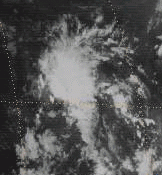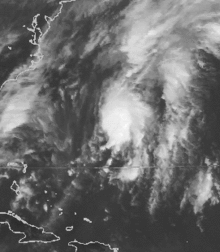Timeline of the 1982 Atlantic hurricane season
The 1982 Atlantic hurricane season was an event in the annual tropical cyclone season in the north Atlantic Ocean. It was an inactive Atlantic hurricane season, during which only five tropical cyclones formed.[1] The season officially began on June 1, 1982 and ended November 30, 1982. These dates, adopted by convention, historically describe the period in each year when most systems form.[2] this year, however, most tropical activity was constrained to the month of September.

This season produced eight tropical depressions, of which five became named storms; two attained hurricane status, of which one became a major hurricane, a storm that ranks as a Category 3 or higher on the Saffir–Simpson scale.[1] Hurricane Alberto, the season's first named storm, was one of four storms on record to attain hurricane status in the Gulf of Mexico that not make landfall. The other three were Laurie of 1969,[1] Henri of 1979,[3] and Jeanne of 1980.[4] None the less, rains from Alberto caused severe flooding, which killed 23 people in Cuba.[5] The season's only major hurricane, Debby, reached peak intensity as a weak Category 4 over the open waters of the Atlantic.[6] Tropical Storm Ernesto, the last storm of the season, peaked in intensity on October 2 just below hurricane strength. It then dissipated the next day,[7] 58 days before the official end of the season.[8]
This timeline documents tropical cyclone formations, strengthening, weakening, landfalls, extratropical transitions, and dissipations during the season. It includes information that was not released throughout the season, meaning that data from post-storm reviews by the National Hurricane Center, such as a storm that was not initially warned upon, has been included.
By convention, meteorologists one time zone when issuing forecasts and making observations: Coordinated Universal Time (UTC), and also use the 24-hour clock (where 00:00 = midnight UTC).[9] In this time line, all information is listed by UTC first with the respective local time included in parentheses.
Timeline of storms

June
- June 1
- The Atlantic hurricane season officially begins.[8]
- June 2
- June 3
- 2 a.m. EDT (0600 UTC) – Tropical Depression One strengthens into Tropical Storm Alberto.[10]
- 2 p.m. EDT (1800 UTC) - Tropical Storm Alberto strengthens into a hurricane.[10]
- June 4
- June 6
- 8 a.m. EDT (1200 UTC) - Tropical Depression Alberto degenerates into a tropical disturbance shortly before dissipating.[10]
- June 17
- 8 p.m. EDT (0000 UTC June 18) - Subtropical Depression One forms 280 miles (450 km) west-southwest of Cape Coral, Florida.[11]
- June 18
- 8 a.m. EDT (1200 UTC) - Subtropical Depression One strengthens into a Subtropical Storm and makes landfall near Spring Hill, Florida, with winds of 45 mph (75 km/h).[11]
- June 19
- 8 a.m. EDT (1200 UTC) - Subtropical Storm One makes landfall on the Outer Banks of North Carolina with winds of 70 mph (110 km/h).[11]
- June 20
- 2 p.m. EDT (1800 UTC) - Subtropical Storm One transitions into an extratropical cyclone just south of Newfoundland.[11]
July
- No tropical cyclones formed during the month of July.
August
- August 28
- August 29
- 2 a.m. AST (0600 UTC) - Tropical Storm Beryl makes its closest approach to the Cape Verde Islands, passing 40 miles (65 km) south of the island of Brava with winds of 45 mph (75 km/h).[12]
September
- September 2
- 2 p.m. AST (1800 UTC) - Tropical Storm Beryl weakens to a tropical depression.[12]
- September 5
- 8 p.m. AST (0000 UTC September 6) - Tropical Depression Three forms 560 miles (900 km) east of Guadeloupe.[1]
- September 6
- 2 p.m. AST (1800 UTC) - Tropical Depression Beryl dissipates over open waters.[12]
- September 8
- 7 p.m. CDT (0000 UTC September 9) - Subtropical Depression Two forms 265 miles (425 km) south-southeast of New Orleans, Louisiana.[13]
- September 9
- September 10
- 7 a.m. CDT (1200 UTC) - The Unnumbered Tropical Depression strengthens into Tropical Storm Chris.[13]
- September 11
- 7 a.m. CDT (1200 UTC) - Tropical Storm Chris makes landfall near Sabine Pass, Texas with winds of 65 mph (100 km/h).[13]
- 7 p.m. CDT (0000 UTC September 12) - Tropical Storm Chris weakens to a tropical depression.[13]
- September 12
- September 13
- 8 a.m. AST (1200 UTC) - Tropical Depression Five forms 95 miles (150 km) north-northeast of Santo Domingo, Dominican Republic.[14]
- September 14
- 8 a.m. AST (1200 UTC) - Tropical Depression Five strengthens into Tropical Storm Debby.[14]
- 8 p.m. AST (0000 UTC September 15) - Tropical Storm Debby strengthens into a hurricane.[14]
- September 15
- 2 p.m. AST (1800 UTC) - Hurricane Debby strengthens into a Category 2 hurricane.[14]
- September 16
- exact time unknown - Tropical Depression Six forms 900 miles (1,400 km) west of the Cape Verde Islands.[15]
- September 17

- September 18
- 2 a.m. AST (0600 UTC) - Hurricane Debby weakens to a Category 3 hurricane.[14]
- 8 p.m. AST (0000 UTC September 19) - Hurricane Debby weakens to a Category 2 hurricane and makes its closest approach to Newfoundland, passing within 95 miles (150 km) of the southeastern shore with winds of 105 mph (165 km/h).[14]
- September 19
- 2 a.m. AST (0600 UTC) - Hurricane Debby weakens to a Category 1 hurricane.[14]
- September 20
- 2 a.m. AST (0600 UTC) - Hurricane Debby weakens to a tropical storm.[14]
- 2 p.m. AST (1800 UTC) - Tropical Storm Debby transitions into an extratropical cyclone over open waters.[14]
- exact time unknown - Tropical Depression Six dissipates 750 miles (1,210 km) east of the Leeward Islands.[16]
- September 23
- 8 p.m. AST (0000 UTC September 24) - Tropical Depression Seven forms 365 miles (590 km) west of Nassau, Bahamas.[1]
- September 27

- 8 a.m. AST (1200 UTC) - Tropical Depression Seven dissipates over open waters.[1]
- September 30
- 8 a.m. AST (1200 UTC) - Tropical Depression Eight forms 445 miles (720 km) northeast of the Turks and Caicos Islands.[7]
October
November
- November 30
- The Atlantic hurricane season officially ends.[8]
See also
Notes
- The figures for maximum sustained winds and position estimates are rounded to the nearest 5 units (knots, miles, or kilometers), following the convention used in the National Hurricane Center's operational products for each storm. All other units are rounded to the nearest digit.
References
- National Hurricane Center (2008). "All Tropical Cyclone Tracks for the Atlantic and Eastern Pacific". Hydrometeorological Prediction Center. Retrieved 2008-11-20.
- Dorst, Neal (June 1, 2018). "Hurricane Season Information". Frequently Asked Questions About Hurricanes. Miami, Florida: NOAA Atlantic Oceanographic and Meteorological Laboratory. Retrieved June 29, 2020.
- National Hurricane Center (1979). "Hurricane Henri (1979) Preliminary Report Page 1". National Hurricane Center. Retrieved 2007-11-28.
- National Hurricane Center (1980). "Hurricane Jeanne (1980) Preliminary Report". National Hurricane Center. Retrieved 2007-11-12.
- National Hurricane Center (1982). "Hurricane Alberto Preliminary Report Page 2". National Hurricane Center. Retrieved 2008-11-21.
- National Hurricane Center (1982). "Hurricane Debby Preliminary Report Page 3". National Hurricane Center. Retrieved 2008-11-21.
- National Hurricane Center (1982). "Tropical Storm Ernesto Preliminary Report Page 4". National Hurricane Center. Retrieved 2008-11-21.
- Atlantic Oceanographic and Meteorological Laboratory, Hurricane Research Division. "Frequently Asked Questions: When is hurricane season?". National Oceanic and Atmospheric Administration. Archived from the original on 2006-07-18. Retrieved 2008-11-03.
- "Understanding the Date/Time Stamps". miami, Florida: NOAA National Hurricane Center. Retrieved July 10, 2020.
- National Hurricane Center (1982). "Hurricane Alberto Preliminary Report Page 6". National Hurricane Center. Retrieved 2008-11-21.
- National Hurricane Center (1982). "Subtropical Storm One Preliminary Report Page 7". National Hurricane Center. Retrieved 2008-11-21.
- National Hurricane Center (1982). "Tropical Storm Beryl Preliminary Report Page 5". National Hurricane Center. Retrieved 2008-11-21.
- National Hurricane Center (1982). "Tropical Storm Chris Preliminary Report Page 2". National Hurricane Center. Retrieved 2008-11-21.
- National Hurricane Center (1982). "Hurricane Debby Preliminary Report Page 5". National Hurricane Center. Retrieved 2008-11-21.
- Associated Press. Hurricane brushes past Bermuda. Retrieved on 2008-05-23.
- Associated Press. Debby weakens; depression forms. Retrieved on 2008-05-23.